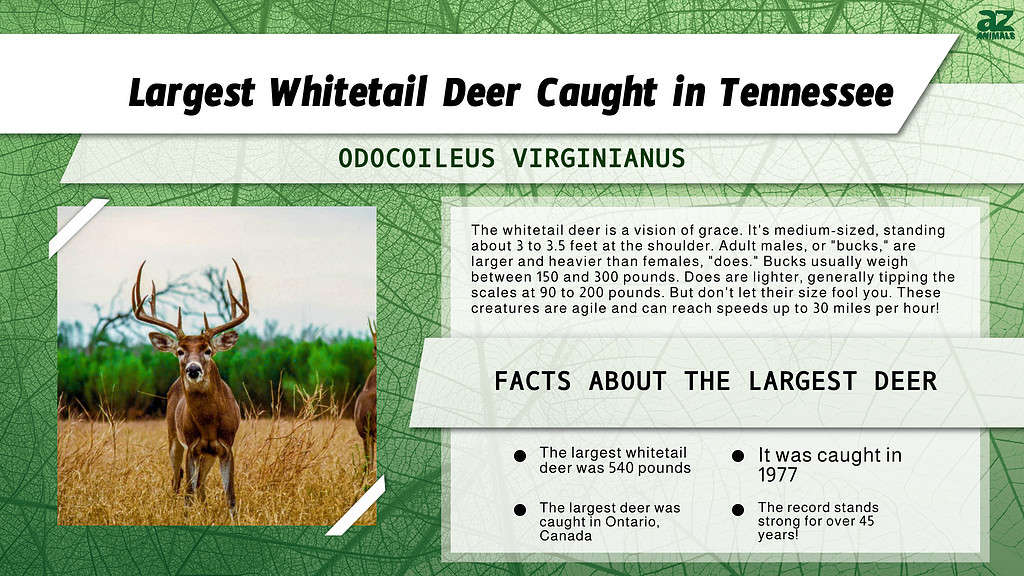
The whitetail deer, a cherished symbol of the American wilderness and Tennessee’s official wildlife animal is a fascinating species with a rich ecological presence in the state. These adaptable creatures are known for their grace and agility, and their population is widespread across Tennessee’s diverse landscapes, from the Appalachian Mountains in the east to the Mississippi River lowlands in the west.
In this article, we discover the largest whitetail deer ever caught in Tennessee. We also delve into various aspects of the whitetail deer’s life in Tennessee.
We’ll explore their distinct physical attributes, their preferred habitats, and their diet.
Finally, we’ll examine the population dynamics of these animals in the state, the nature of their interactions with humans, and the critical role of ongoing conservation efforts in ensuring their survival.
The Largest Whitetail Deer Ever Caught in Tennessee
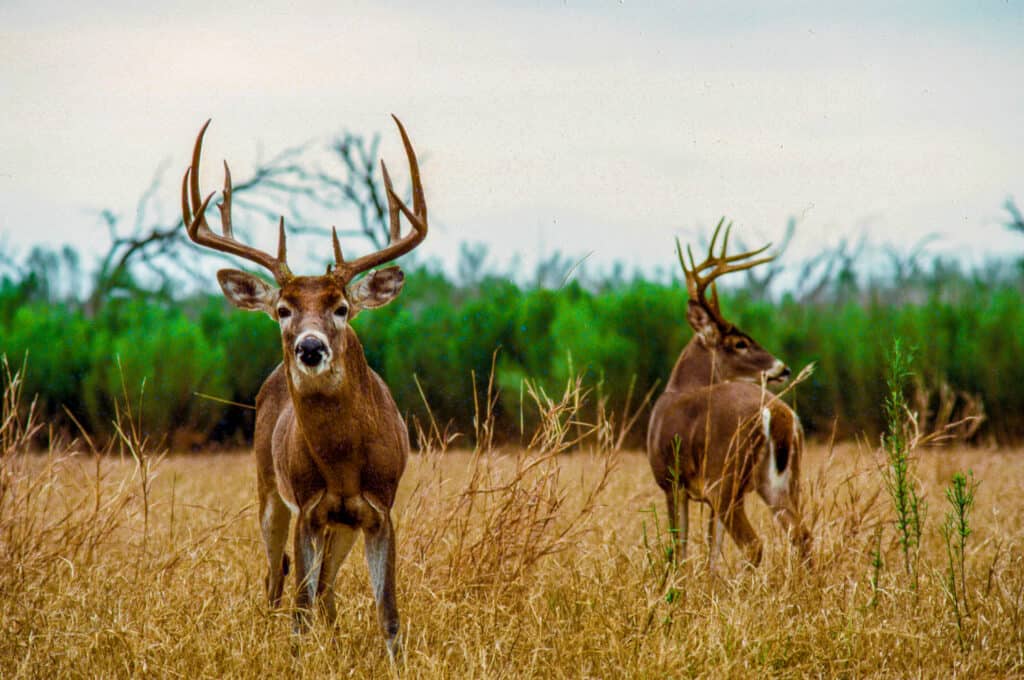
Whitetail bucks usually weigh between 150 and 300 pounds.
©iStock.com/Dan Richards
The largest whitetail deer ever caught in Tennessee scored an impressive 315 1/8. Stephen L. Tucker caught the non-typical whitetail deer in 2016. Bass Pro Shops currently own the prized catch.
The Largest Whitetail Deer Ever Caught Worldwide
The record for the largest whitetail deer ever documented belongs to an enormous buck, estimated to tip the scales at a staggering 540 pounds. This colossal male was hunted and brought down by John Annett in Ontario, Canada, in 1977, and it’s often speculated to be the largest whitetail deer ever witnessed. This deer surpassed the prior record, which had remained unbroken for more than half a century. Remarkably, this gigantic deer’s record seems to stand firm, as no other whitetail has approached its colossal size in the subsequent 45 years.
Description and Physical Characteristics
Let’s take a moment to picture the whitetail deer. As its name implies, the deer’s most distinctive feature is its large, white tail. When it senses danger or runs, it lifts its tail like a flag, showing off its white underside.
Graceful and Agile Stature
The whitetail deer is a vision of grace. It’s medium-sized, standing about 3 to 3.5 feet at the shoulder. Adult males, or “bucks,” are larger and heavier than females, “does.” Bucks usually weigh between 150 and 300 pounds. Does are lighter, generally tipping the scales at 90 to 200 pounds. But don’t let their size fool you. These creatures are agile and can reach speeds up to 30 miles per hour!
The Iconic Antlers
Now, let’s talk about those iconic antlers. Only bucks sport these impressive headpieces. Antlers are a symbol of age and status among bucks. They shed and regrow them every year. They start growing in the spring, covered in a soft tissue called “velvet.” By late summer, the velvet falls off, revealing hardened antlers ready for the fall breeding season.
Distinctive Markings
The whitetail’s coat color changes with the seasons in Tennessee. In the summer, their thin coat is reddish-brown. When winter comes, they grow a thicker, darker coat that helps them blend into the barren landscape and stay warm. However, their underside, inner ears, and the ring around their eyes and nose remain white year-round.
Lifespan and Life Cycle
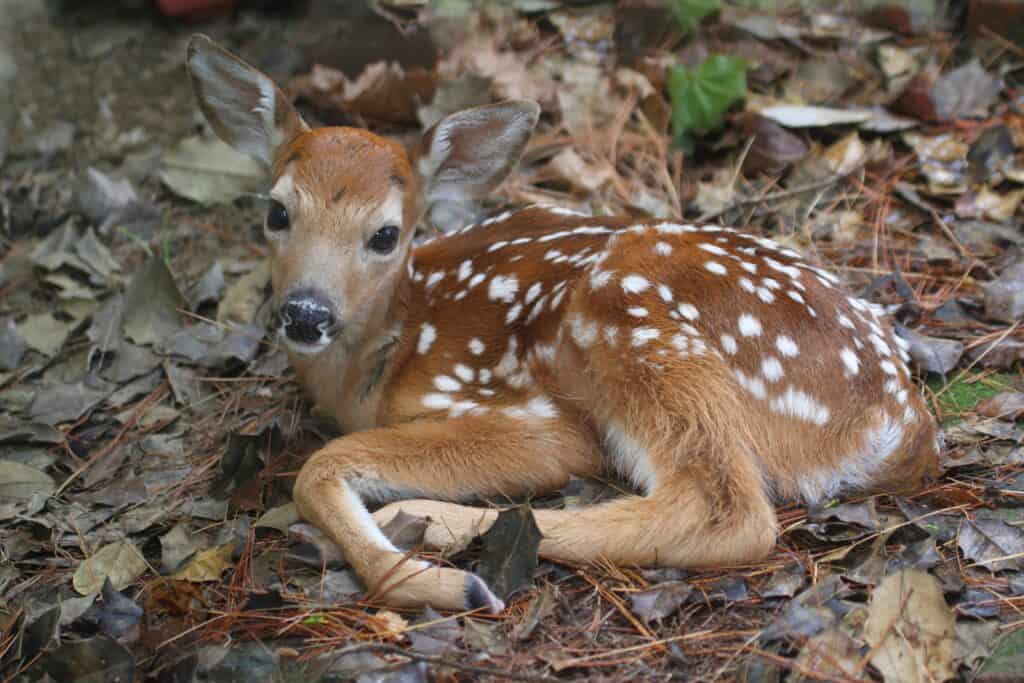
Whitetail deer have white spots all over their bodies when they are young.
©Steve Byland/Shutterstock.com
Whitetail deer have a life span of about 10 to 12 years in the wild, but most only live about 4 to 5 years. They start life as spotted fawns, born in late spring. By their first birthday, young bucks begin to grow their first set of antlers and do reach reproductive maturity. From then on, they continue the cycle, contributing to the next generation of Tennessee’s majestic whitetail deer.
Where Do Whitetail Deer Live?
The habitats of Tennessee’s whitetail deer are as diverse as they are picturesque. So let’s step into their world and explore these landscapes more deeply.
Living on the Edge: The Appeal of Forests
Whitetail deer are truly creatures of the edge. The edge, in ecological terms, refers to the transition zone where two different plant communities meet, like a forest and a meadow. This kind of habitat offers the best of both worlds.
In the dense cover of the forest, deer find safety from predators. Here, they rest, ruminate, and escape the heat of summer days. In contrast, the open areas are a rich buffet of grasses, herbs, and broad-leafed plants, making them prime foraging spots.
Water Bodies: A Crucial Resource
Deer, like all living creatures, need water to survive. Therefore, rivers, streams, and other water bodies within their habitats serve as crucial drinking sources. Not only that, but the vegetation near these water bodies often provides excellent forage and cover.
Adapting to the Seasons

Deer have special muscles that can adjust the angle of their hair shafts to keep them warm during winter.
©iStock.com/Matt Dirksen
Whitetail deer are tuned in to the rhythm of the seasons. In summer, they opt for cooler, shady forests with plenty of undergrowth. This dense cover protects them from the summer heat while providing a place to hide from predators.
Winter sends them seeking out areas with evergreen trees and shrubs. The evergreen plants offer some degree of cover even in the snowy season, and the lower-lying vegetation can be a crucial food source when other options are buried under the snow.
Spring and autumn, with their explosion of plant life, find deer venturing into more open spaces, such as meadows, farmlands, and even suburban gardens, where fresh shoots, flowers, and crops are abundant.
The Urban Challenge
As cities and towns spread, forests and meadows give way to houses, roads, and shopping centers. But this hasn’t stopped the whitetail deer. Instead, these adaptable creatures have managed to carve out a place in suburban landscapes, swapping forest undergrowth for decorative shrubs and garden greens.
Yet, this move towards human-dominated areas isn’t without its challenges. Increased human-deer encounters, road accidents, and property damage are just some issues arising from this shared space. Understanding and managing these interactions is crucial, a topic we’ll delve into in later sections.
Diet and Foraging Behavior
Let’s turn our attention to the culinary preferences of the whitetail deer. These creatures are herbivores, feasting on a variety of plants, fruits, and nuts. But what they eat changes with the seasons and available food sources. Let’s delve into their menu and dining habits, shall we?
A Taste for Variety: Generalist Feeders

Whitetail deer are generalist feeders which means that they will eat a wide range of different plants and will change their died based on what’s around them.
©iStock.com/steverts
Whitetail deer are considered generalist feeders. This means they can eat a wide range of plants, adjusting their diet based on what’s available each season. From the tender shoots of spring, the succulent berries of summer, to the fallen acorns of autumn, and the hardy bark of winter trees, the whitetail deer’s diet is diverse and flexible. This adaptability has undoubtedly contributed to their survival and success.
Summer and Spring: A Feast of Greens
When spring rolls around, new life burgeons across the landscape and a feast awaits the deer. First, they munch on tender shoots, new leaves, and even wildflowers. Then, as the warmth of summer takes hold, this green buffet expands to include a variety of grasses, herbs, and the juicy fruits of berry plants.
Fall and Winter: Survival Mode
As autumn arrives and the trees shed their leaves, deer turn to hard masts like acorns and hickory nuts. These high-energy foods help them build fat reserves to survive the winter. When winter hits in full force, and the ground is blanketed in snow, deer scrape by on whatever they can find—tree bark, twigs, and any remaining nuts.
Foraging Tactics: Crepuscular Feeders
Whitetail deer are crepuscular, meaning they are most active during dawn and dusk. These times offer the perfect balance between visibility and safety. The dim light allows them to spot predators while staying inconspicuous.
The Impact of Diet on Health and Migration
The quality and availability of food significantly influence the deer’s health, size, and longevity. Nutrient-rich diet contributes to larger body size, healthier fawns, and better survival rates. It also affects their migration patterns. Deer will often move across their home range following the seasonal availability of food, always in search of a good meal.
Whitetail Deer Population in Tennessee
Let’s delve deeper into the dynamics of the whitetail deer population in Tennessee. We’ll bring in more details and statistics to paint a clearer picture of their thriving existence in the Volunteer State.
An Overview of Population Distribution
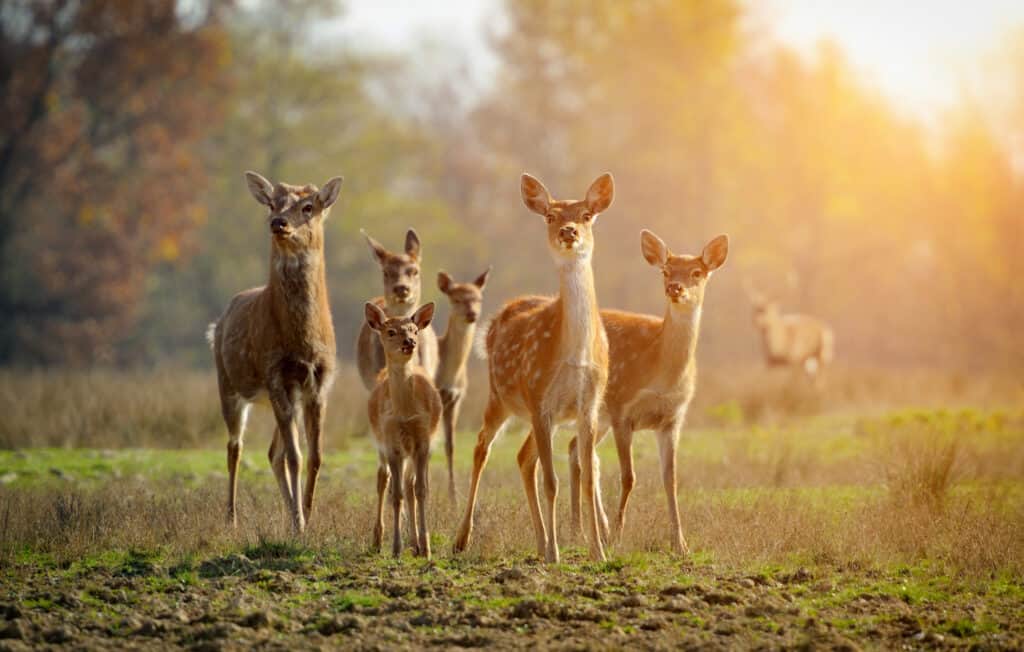
Today there are over 25 million deer in the United States, and numbers are rising.
©Volodymyr Burdiak/Shutterstock.com
Tennessee is home to an estimated 900,000 whitetail deer, a substantial increase from numbers recorded in the mid-20th century. These deer are not evenly distributed across the state. Instead, they tend to concentrate on areas with abundant natural resources and less human activity.
The largest densities of deer can be found in regions such as Middle Tennessee and parts of West Tennessee. These areas, rich in forests and agricultural lands, offer the perfect blend of food, cover, and water. Here, deer populations can reach up to 30 deer per square mile.
On the flip side, urban areas and regions with intensive agriculture or significant human activity tend to have lower deer densities. This is primarily due to habitat loss and increased human-wildlife conflicts.
Unpacking Population Trends and Dynamics
The deer population in Tennessee hasn’t always been this high. In the early 1900s, excessive hunting and habitat loss had brought the whitetail deer population to alarmingly low levels. However, conservation and management efforts that began in the mid-20th century have been largely successful, and today, the whitetail deer is a common sight across the state.
However, the population dynamics of deer continue to be complex, influenced by various natural and human-induced factors. For example, disease outbreaks like chronic wasting disease, severe weather events, hunting pressure, and vehicle collisions all play a role in shaping deer population trends.
Digging into Birth Rates, Mortality, and Migration
Every spring, the birth of fawns contributes to a population increase in Tennessee’s deer. But not all these fawns will make it to adulthood. Natural causes such as predation, disease, and extreme weather conditions can cause high fawn mortality rates, sometimes affecting up to 50% of newborns.
Human activities also significantly impact the deer population. Legal hunting in Tennessee results in the harvest of approximately 150,000 to 200,000 deer each year. This managed hunting helps maintain a healthy and balanced deer population and is an essential tool in wildlife management. Regrettably, vehicle collisions also account for a considerable number of deer deaths annually, estimated in the thousands.
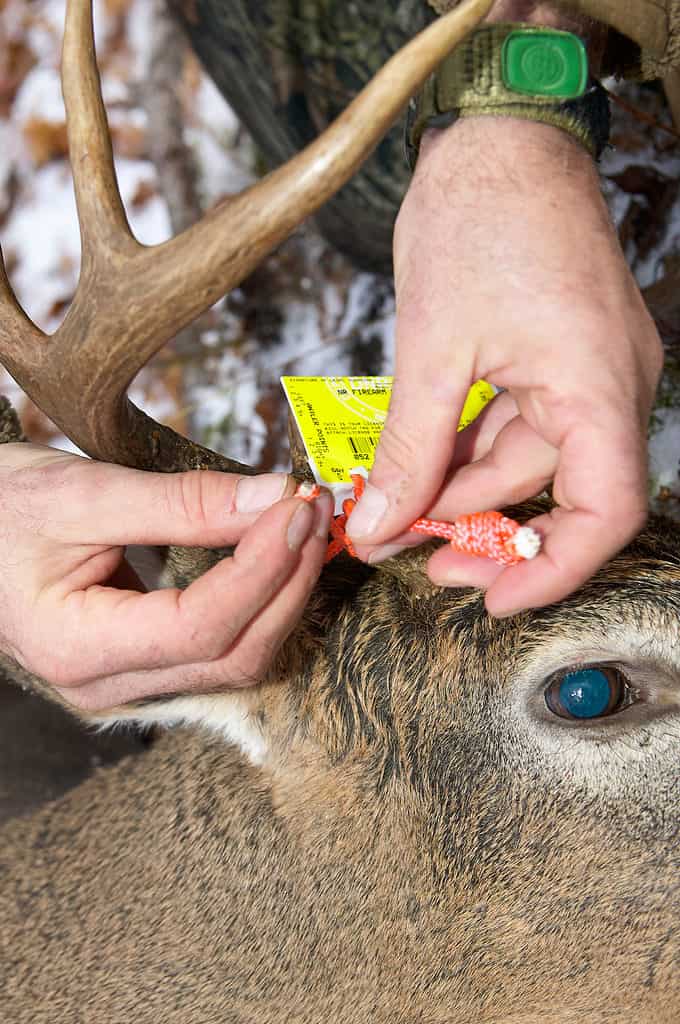
Hunters apply deer hunting quota tags to their catches to show that their hunt was legal and to facilitate transporting the body.
©CLP Media/Shutterstock.com
While not as dramatic as in some species, deer migration does occur and can influence population numbers and distribution. Seasonal changes in food availability, disturbances such as habitat alteration, or extreme weather conditions can cause deer to move within their home ranges or even venture beyond them.
Human-Deer Interactions in Tennessee
Living in a world that’s increasingly human-dominated, whitetail deer have learned to adapt. But their increased proximity to us leads to various interactions, some positive and others challenging. So let’s take a closer look at the complex relationship between humans and deer in Tennessee.
The Beauty and the Beast: A Love-Hate Relationship
It’s hard not to admire the grace and beauty of the whitetail deer. Their presence adds a touch of wildness to our landscapes, whether it’s a rural backyard or the edge of a suburban park. Many Tennesseans enjoy observing deer, photographing them, or hunting them for sport and sustenance.
However, the relationship isn’t always rosy. As deer populations have grown and their habitats overlapped with human territories, problems have emerged. Crop damage, garden grazing, and vehicle collisions are just a few of the challenges associated with our deer neighbors.
The Bittersweet Harvest: Deer and Agriculture
Farmers in Tennessee often have mixed feelings about their deer neighbors. On the one hand, these graceful creatures can be a pleasure to observe roaming through the fields at dusk. But on the other hand, deer can cause significant damage to crops. Corn, soybeans, wheat, and various fruits and vegetables are all susceptible to deer grazing. In some parts of the state, farmers report losses of thousands of dollars due to deer damage annually.
Danger on the Roads: Vehicle Collisions
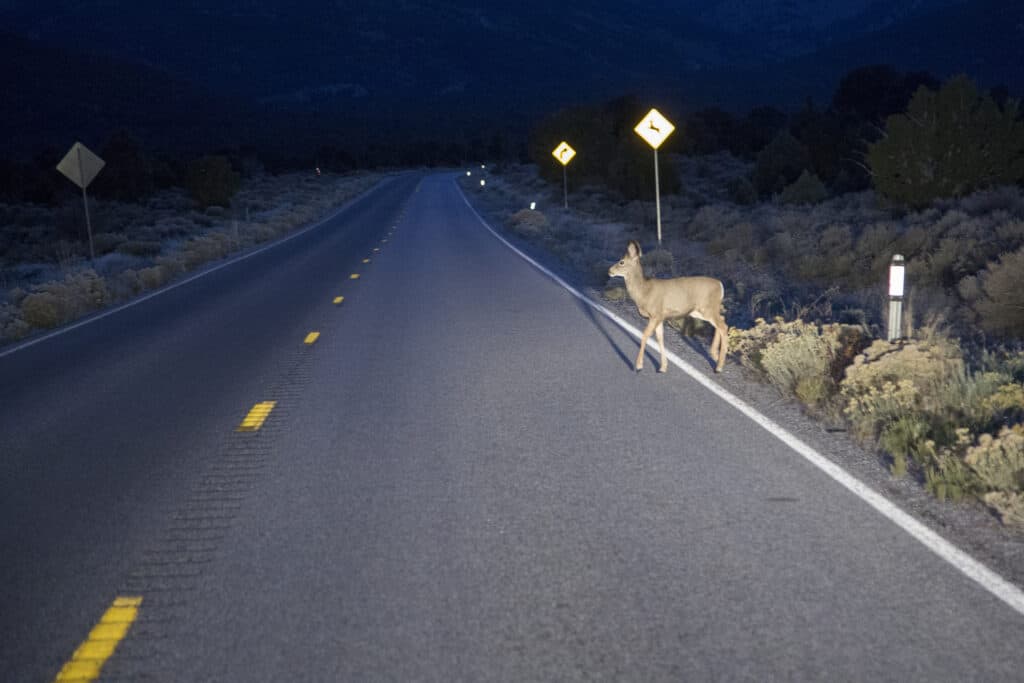
Overpopulation in these areas makes collisions with vehicles more common.
©iStock.com/frontpoint
Unfortunately, one of the most dangerous forms of human-deer interaction in Tennessee involves our vehicles. An estimated 6,000 deer-vehicle collisions occur each year in the state. These accidents can cause serious harm to people and property, not to mention the deer themselves.
Deer in the Suburbs: Suburban Challenges
Suburban landscapes provide a surprising amount of food for deer, from ornamental plants and garden vegetables to fruits and nuts. Unfortunately, this availability can attract deer, leading to encounters that some residents find less than desirable. From destroyed landscapes to concerns about ticks and Lyme disease, suburban living with deer presents unique challenges.
Key Takeaways
We’ve come to the end of our exploration of the largest whitetail deer in Tennessee. From understanding their physical traits and habitats to examining their diet, population distribution, and human interactions, we’ve navigated the complex and fascinating world these animals inhabit.
The whitetail deer is more than just an iconic presence in the Tennessee landscape. They play a crucial role in the state’s ecological balance and biodiversity. Seeing a deer in the wild is always a special moment, reminding us of nature’s resilience and beauty.
However, the conservation of this species is an ongoing challenge. It requires a careful balance of habitat management, population control, and respect for wildlife from all of us. Continued research is also essential to enhance our understanding and refine our management strategies.
The photo featured at the top of this post is © Tony Campbell/Shutterstock.com
Thank you for reading! Have some feedback for us? Contact the AZ Animals editorial team.






